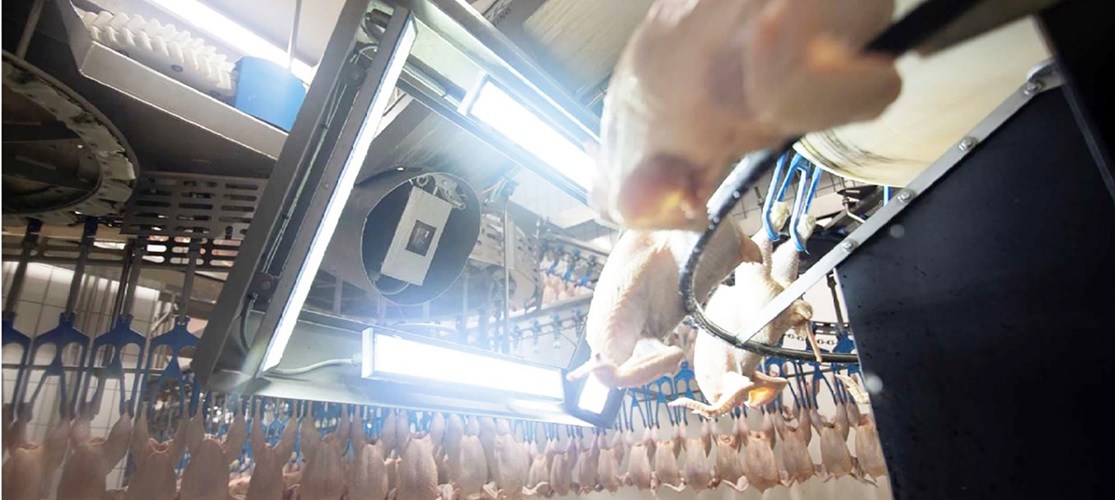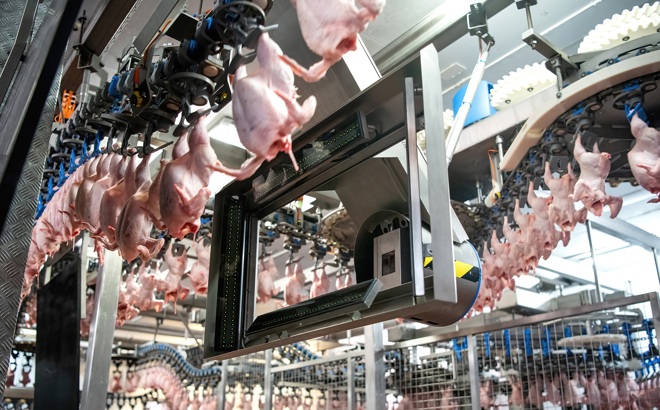It takes less than a second to make important decisions about a pending customer order.
Jeroen Pol
Marel poultry product specialist

Intelligent sensors, autonomous robots, smart software as well as vision, scan and laser technologies are examples of high-quality techniques within the food sector, always with the aim of continuously supplying the world with food and responding to the changing food chain. It is crucial to produce more efficiently, more effectively, more sustainably and differently, both in machine construction and in food processing. This is exactly the purpose of Marel's IRIS vision grading technology.

1. Why do poultry processors need vision grading?
Poultry processing companies are running ever higher capacities, with the demand for reliable insight into the quality of the incoming products. Because it is not very sustainable to completely downgrade a whole chicken because of one damaged part, poultry processors are looking for means to determine the quality per chicken part. For this purpose, Marel has developed the computer-controlled IRIS optical system. IRIS stands for Intelligent Reporting, Inspection & Selection.
IRIS' high-tech digital camera can capture a high-resolution image of each of the rapidly passing products. This enables exceptional inspection and selection performance at the highest line speeds. Advanced Innova recognition software processes the camera images and determines the quality of whole products and each of their seven anatomical parts (two wings, two thighs, two drumsticks and a chest). This information is used to determine the best possible sales destination for the products. Even lower-valued whole products or chicken parts can be processed as efficiently as possible. In this way, all product parts provide maximum value for the processor.

2. Where is vision grading being done in the processing plant?
IRIS is an extremely flexible system. It can be installed in as many as four different locations in the factory, each with different benefits. Jeroen Pol, Marel poultry product specialist, says: “Almost immediately after arrival, the products, including feathers, can already be visually assessed by IRIS DF to determine the quality of the total flock. In the subsequent phase, still before the chilling phase, the products have an optimal presentation with stretched wings and legs, so that IRIS EV can spot various things well at that location.” Shape, color and texture are assessed to spot defects such as bruises, fractures, skin lesions, feather remains and fecal matter.
After cooling, IRIS GDR can also view the products in their final form, in order to determine their final destination: will they be chicken legs in a bulk packaging or will they be precisely weighed fillets on a tray? In a phase further downstream, IRIS NT can examine individual chicken parts such as wings even better. “Wherever IRIS is in the process, the visual assessment is super fast; it takes less than a second to make important decisions about a pending customer order,” says Jeroen Pol.
Even in the final processing stage, when fillets are conveyed on a belt, it is possible to apply vision grading for quality assessment and distribution. Combined with product sensors, Innova PDS and a fillet distribution system, Marel’s IRIS FI (Fillet Inspection) camera is able to filter out products that don't meet the criteria.

3. Does vision grading add to product quality?
Of course! This is the raison d’être for vision grading. Because of its ability to detect defects, vision grading plays an essential role in supplying highest quality food. In almost any stage of the process, vision grading is an indispensable quality assurance to prevent unwanted products from ending up in the packing area. Products that feature fractures, bruises, blood spots, fat, skin, or otherwise don’t meet the set criteria will be identified sooner or later in the process. At the end of the day, only A-grade products (whole grillers or cuts) will make it to the end of the regular process and can be found on the supermarket shelves. Rejected products will be processed alternatively, which, in the end, will also result in high-quality end products in other domains, such as nuggets, burgers, sausages and more.
It takes less than a second to make important decisions about a pending customer order.
Jeroen Pol
Marel poultry product specialist

4. Does vision grading add to sustainability?
Carcass balance, or the need to use all parts of an animal in a profitable way, is a pillar of sustainability in the food industry. Around the planet the awareness of carcass balancing in the poultry industry is growing. For more and more people using just the breast meat of carefully reared chicken and underrating the rest, perfectly edible food rich in proteins, is not making sense. One small damaged part may not be the reason to completely downgrade a whole chicken; that is not very sustainable.
For maximum carcass balance, vision grading is the ideal tool: precise assessment at the right time and at the right spot enables the optimal use of every part of the chicken to make a valuable end product. No part is left unused; products of lower visual quality aren’t thrown away. On the contrary, these perfectly edible parts can very well be further processed into high-quality minced meat products or sausages. And of course, products with an A-grade quality have all options open for the downstream process. They will proceed to the regular production streams, be it as whole product or cut-up. In this way, vision grading adds enormous value to the sustainable use of every product, whatever quality it may have.

5. Does vision grading add to traceability?
In a poultry processing plant, sensors are everywhere, on virtually every machine, to transmit important data to the control room. IRIS vision grading is also part of this, adding its quality assessment data at five possible spots in the factory to the dataset. In this way, management can make informed decisions based on pure facts, without estimates. Marel’s Innova software platform knows how to connect all ends factory-wide, and therefore ensures product tracking from arrival to delivery. Naturally, food safety and food quality are greatly served by this.
Our dedicated team is here to help and answer any questions you may have. Please complete the form, and we’ll get back to you as soon as possible. We look forward to hearing from you.